In the Badimalika region of the Far West, despite an allocation of Rs. 380 million for tourism and infrastructure development, there exists a conspicuous absence of tangible progress on the ground. Regrettably, accountability for these irregularities remains conspicuously absent as well.
Basant Pratap Singh & Bidya Rai |CIJ Nepal
Shashidev Shah, a public health specialist, likes to go on treks and take photos when travelling for work. “This has been my hobby since my school days,” he said during a recent meeting.
When Shah, a resident of Samakhusi in Kathmandu, had come to Bajura for the first time for work, he wanted to visit Badimalika, a sacred temple in the mountains. After he finished his work at Martadi, the district headquarters, he headed to the temple on June 28 braving the rain. Planning to trek for four days to reach the temple, he carried a backpack with some essentials and hired a porter to carry his tent and food.
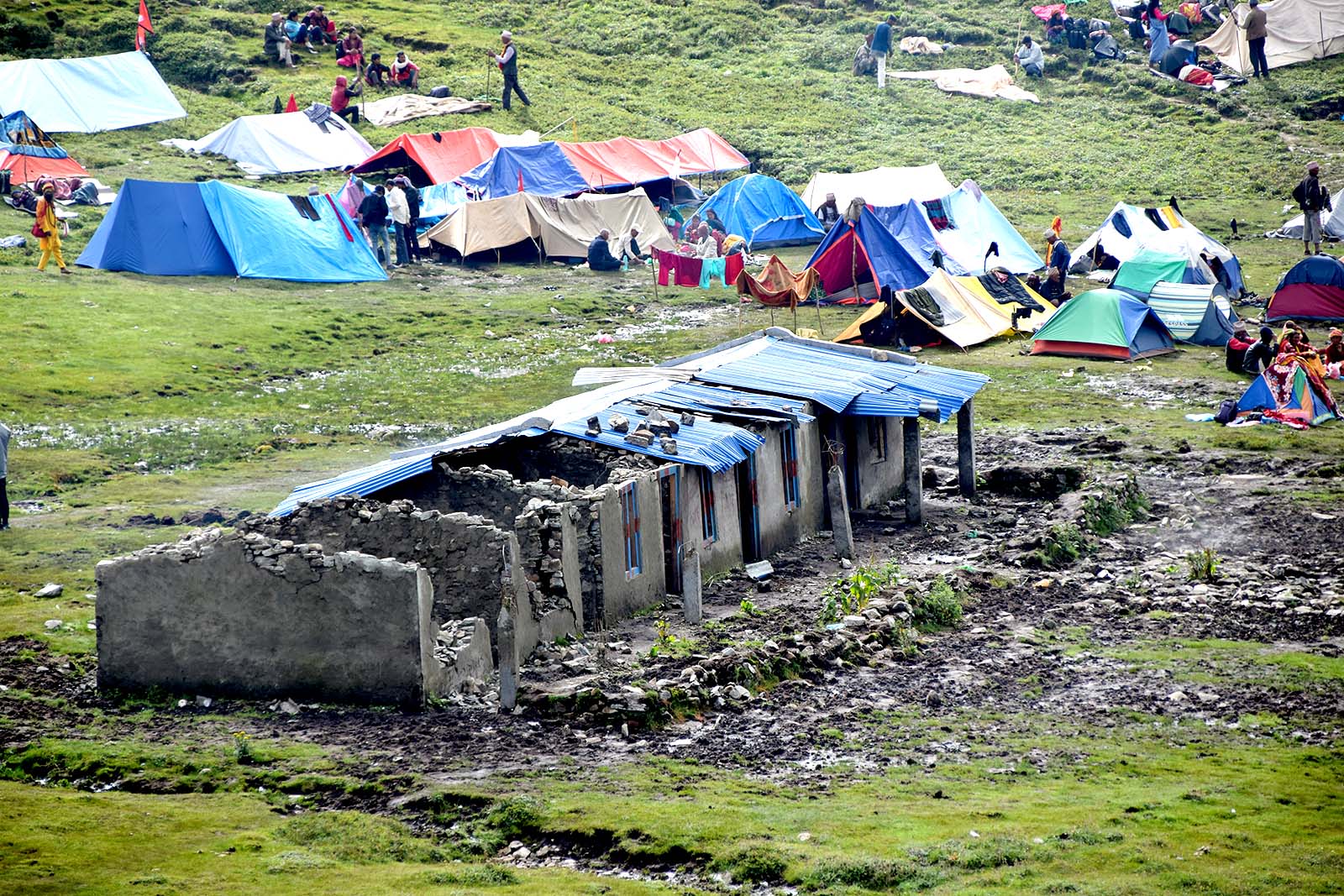
Due to the lack of accommodations, visitors to Badimalika have to set up their own tents. The structures built there in the name of Dharamshala have been destroyed. All photos: Basant Pratap Singh
After returning from the journey, he recalled his experience at a cafe in Durbar Marg. “I started the Badimalika trek on a rainy morning. After walking up and down for half a day, I saw a beautiful waterfall. Different types of plants and animals greeted me along the way.”
But Shah’s excitement soon turned into disappointment. He was appalled by the damage caused by backhoe loaders to the hillsides, which used to be covered with flowers and meadows.
After traveling 41.5 km from Martadi, one reaches Badimalika Temple. Shah’s heart sank as he encountered piles of garbage including discarded shoes, noodle wrappers, gutkha shells, plastic bags, and bottles on the side of Badimalika, which stands at an elevation of 4,200 meters above sea level. “Upon arriving at this sacred site, it felt more like a dumping ground,” he expressed his frustration.
Badimalika is a famous religious, cultural and tourist heritage site in western Nepal. It is located at the border of Bajura and Kalikot districts. Thousands of pilgrims and tourists visit Badimalika every year, especially during the month of Bhadra (August-September), when a grand fair is held.
The path leading to such an important place is risky and uncomfortable. There is no provision of drinking water, toilets or proper accommodation for the visitors. The government has included Badimalika in the list of 100 tourist places that must be visited. However, those who come here after seeing the charming pictures and videos return with complaints like Shah.
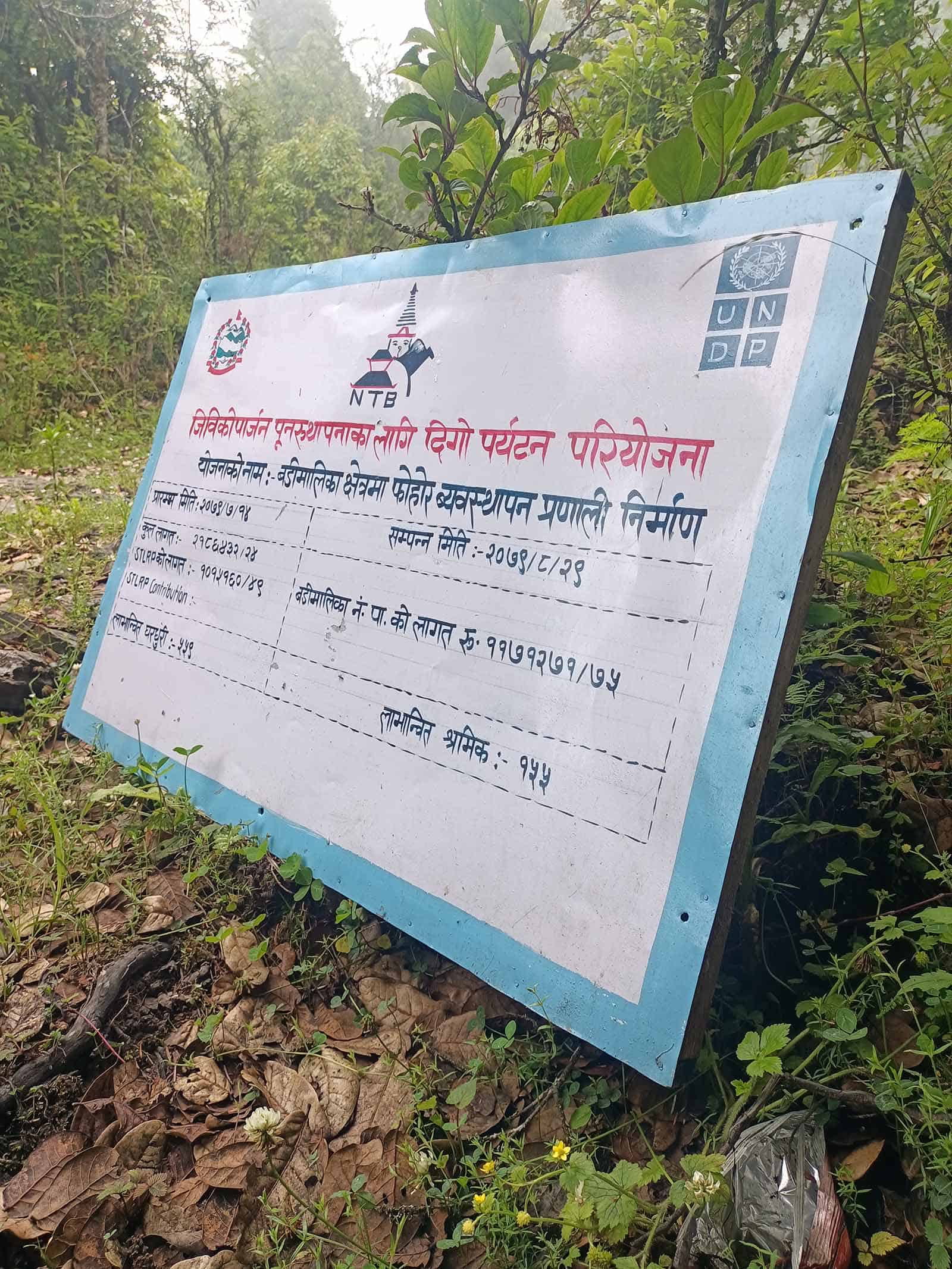
We decided to make the arduous journey to investigate how this region ended up in its current state. We reviewed the information from the relevant agencies and reports of the Auditor General. We also used the right to information to obtain data about the expenditure incurred for the ‘development’ of Badimalika area. We found a huge discrepancy between the money spent by various state bodies and the actual work done on the ground.
We requested information from the Ministry of Culture, Tourism and Civil Aviation, Nepal Tourism Board, Department of Tourism and Department of Archeology about the budget and expenses allocated for tourism development, promotion and construction of basic facilities in this region in the last 10 years. We also obtained details of the expenses incurred by Badimalika and Triveni Municipalities of Bajura and Sannitriveni and Narharinath Rural Municipalities of Kalikot in Sudurpaschim and Karnali Provinces.
All these bodies have together spent a total of 384 million rupees in the name of development in this area in the last decade (from 2012-13 to 2021-22). Despite spending such a huge amount of money, even the footpath leading to Badimalika has not been improved. There is no toilet in that area, no drinking water and no accommodation. Although money has been allocated many times for temple repair, nothing has been done in reality.
Human excreta everywhere
One of the most unpleasant sights for visitors is human excrement everywhere. After leaving Martadi, there are no lodges or hotels on the way. The few places that are called dharamshalas are not habitable. During the four-day trek, visitors have to arrange their own tents. During Janaipurnima, there is no space to pitch tents around Badimalika temple. It is hard to imagine how seven or eight thousand tents can fit in such a steep area.
However, the biggest problem for visitors who have arranged their own accommodation is finding a place to relieve themselves. “People are everywhere; I had to hold it for 14 hours every day,” said Pramila Paudel, who came from Kathmandu to attend the fair. “I woke up at two o’clock in the night to relieve myself; why did I come to such a place?”
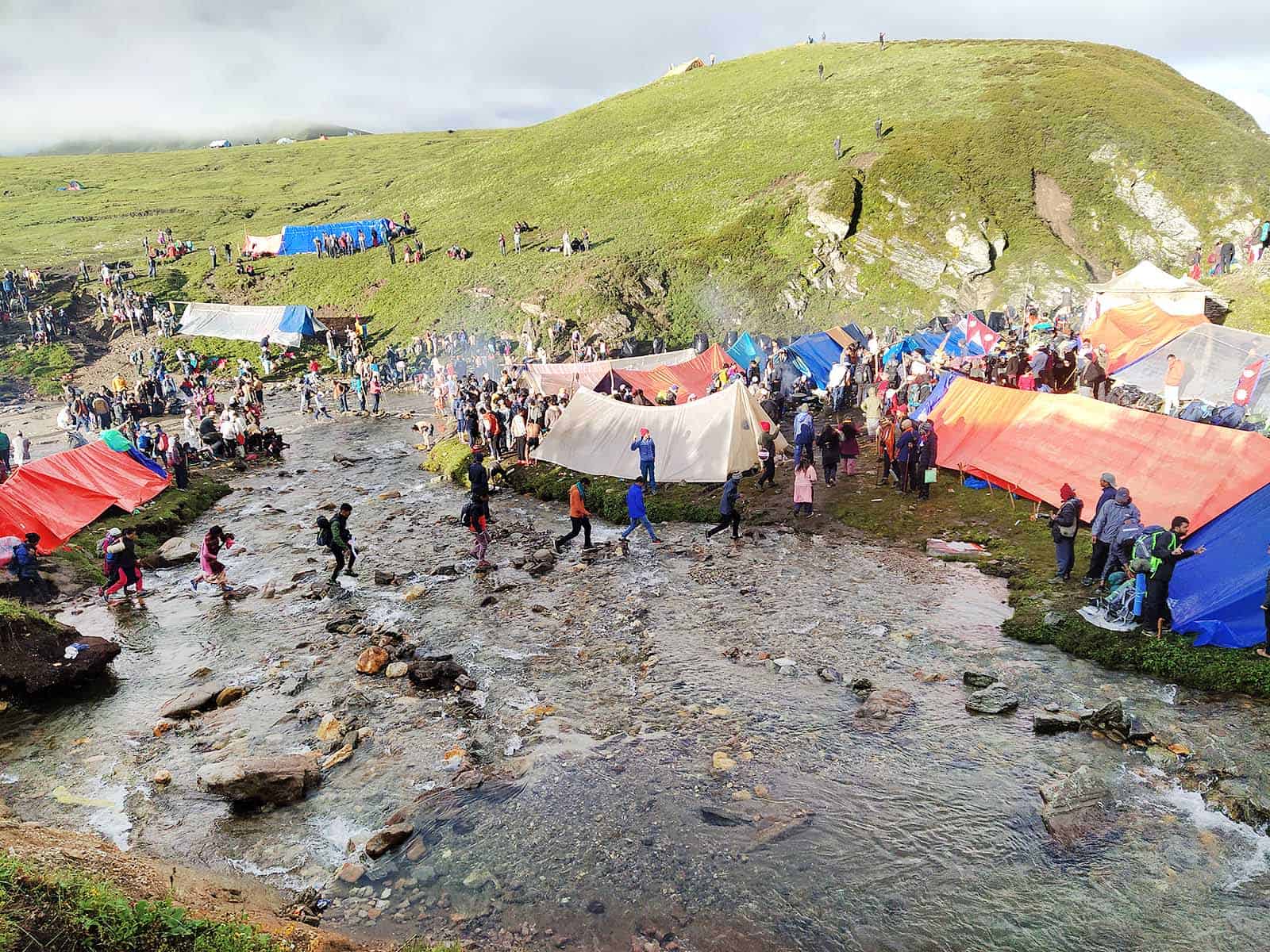
Places such as Badimalika Temple, Triveni Patan, and Bhitichirna, where there are large crowds of visitors lack toilets, and are littered with human excrement. It is almost impossible to walk without stepping on human feces. On the day pilgrims visit Badimalika, they have to bathe in the morning, but there is excrement everywhere on the banks of the Triveni river.
“While the government says that Nepal is free of open defecation, there is only defecation here,” said Man Bahadur Chand, associate professor of the Sudurpaschim Regional University. “Visitors who come to this area with the belief that their prayers will be listened to are forced to step on human feces.”
When we arrived during Janaipurnima last year, we saw some plastic sheets wrapped around poles to make temporary toilets, but they were not usable. In this extremely windy area, the plastic sheets were blown away and stuck in the feces.
The Ministry of Tourism, Department of Archaeology, the provincial government and local levels have not paid any attention to toilets even as they spent Rs 23.9 million to build temples, storehouses and priest’s kitchens. They say they spent Rs 500,000 on the construction of toilets and rest houses, no such structures can be seen on the ground.
Above Phulchhadwana Patan, there is no toilet anywhere on the road until you reach Nateshwari Temple after walking for three days through Sotapatan, Bhitichirna and Triveni Patan. Even in the temple of Badimalika itself, there is not a single toilet. No toilet can be found anywhere above Challesain and Phulchhaduna, which can be reached after walking for about 6 hours from Martadi.
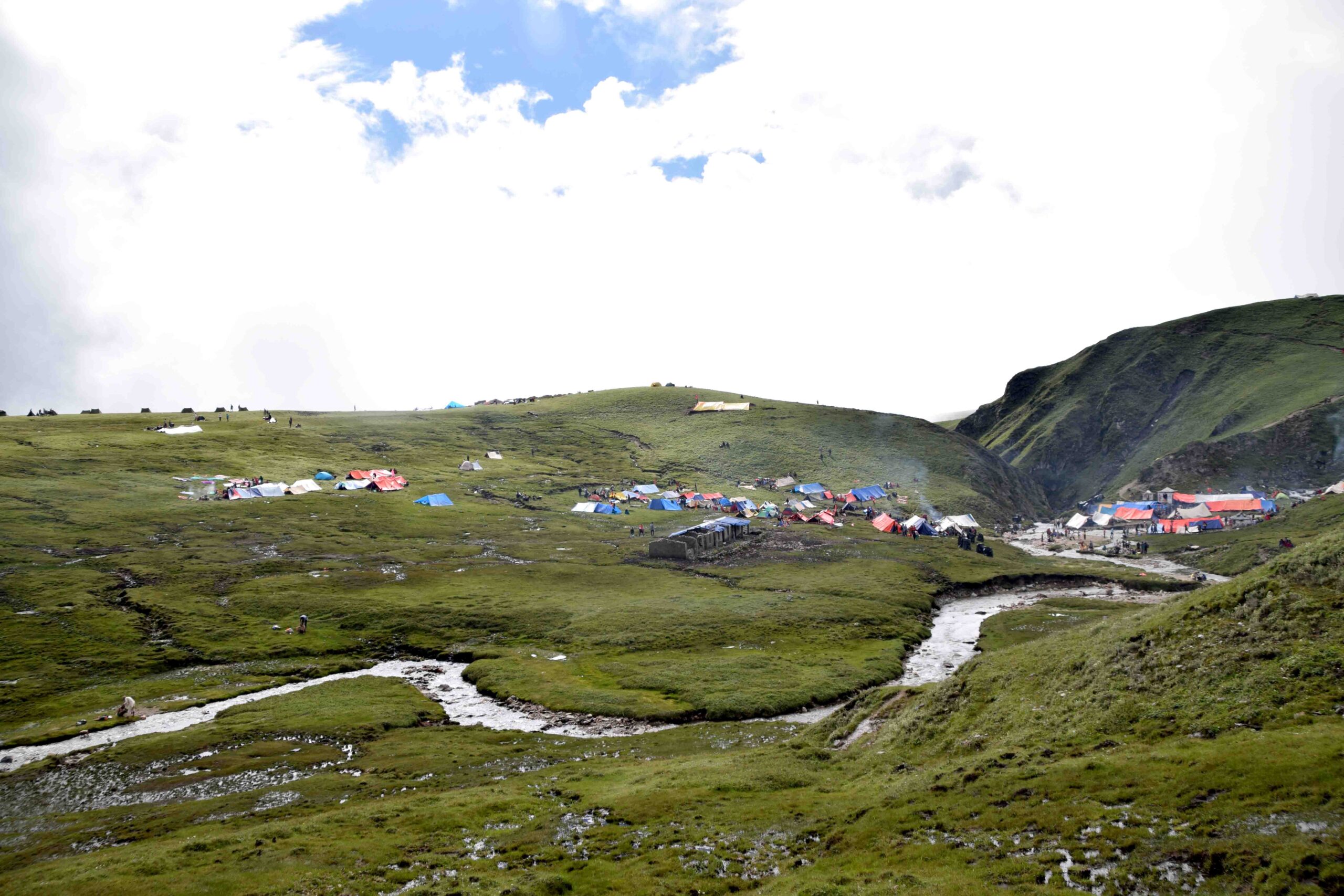
Tents of travelers going to Badimalika.
According to the information provided by the Department of Archeology on September 8, 2022, an allocation of Rs.10.3 million was made in the year 2016/17 for the maintenance and preservation of the Bhandarghar and the footpath leading to the Bhandarghar in Paima village of Badimalika, Triveni municipality. However, due to geographical difficulty, Rs.6.1 million of the allocated funds were used to put a copper roof on the storehouse and repair the road around that house. No work was done on the original temple nor was the road leading to it repaired. In the same year, the Ministry of Tourism also spent Rs 2 million. But in these ten years, no temple maintenance work has been done.
“Those who have access to power have a tendency to secure budget from the government, spend it only on paper, and bag the rest,” Chhak Malla, president of the Federation of Nepalese Journalist, Bajura says, “If the allocated budget were used properly, not only toilets but many other infrastructures could have been built here.”
Documents show that the Department of Archeology has spent Rs. 9.8 million in tourism development and promotion of Badimalika area in the last six years (2013-14 to 2016-17 and 2021-22), and 80 percent of the budget has been spent on the temple itself. However, in reality it is not like that. Papers also show that the Department of Archeology and the Ministry of Tourism spent Rs. 20.082 million only on the temple in 10 years (from 2012-13-70 to 2022-23). The Department of Archeology and the Ministry of Tourism have spent R.10.9 million on the Badimalika main Temple, and the Bhandarghar located in Paima village of Triveni municipality.
However, Netraraja Padhyaya, the main priest, says that after a general renovation in 1980 at the initiative of then King Birendra, there was no work done on the main temple of Badimalika. “In some years, the amount that came has been frozen, and in some years, the budget has been transferred,” he said, “After 1980, no work has been done on the main temple.”
Backhoe loaders on Earth’s heaven
Currently, the road is being built from Martadi to Sotapatan with the investment of the provincial government and the local level. The forest areas, sensitive geography and beautiful meadows have not only become ugly when the dozers cut them, landslides have started in dozens of places. Dozens of new big holes have formed when the mud that flowed through the holes in the road cut by the dozers was collected.

In Badimalika, the roads built with dozers have damaged the forest, meadows, and trails.
Till the last financial year, 208.743 million has been allocated for road construction by various agencies. According to the records on the province’s website, the Sudurpaschim Province government alone has spent 164.1 million for road construction and upgrading in the last four financial years (2019/20 to 2022/23). In Badimalika and Triveni Municipalities of Bajura, Sannitriveni Municipality of Kalikot various programs organisations such as partnership of rural electrification, Road Board Nepal, UNHabitat, UNICEF, MSNP, GIZ of German Government) have spent Rs 41.7 million in four financial years (2018/19 to 2021/22) for road construction to Triveni Patan. Even the federal Ministry of Tourism has spent Rs 2.8 million for roads in the last two years. Even with so much investment, vehicles can reach Sotapatan only in winter.
Tourism professionals say that instead of destroying Badimalika’s environment by competing in road construction, it would be true respect for Badimalika if walking trails were made safer.
No footpath for pedestrians
“There are no basic facilities in the place where so many pilgrims and tourists come,” says Bharat Joshi, a trekking businessman who has visited Badimalika for the 20th time, “It would have been a better idea to invest in a well-organized footpath instead of pouring that amount on the road!”
He says that in some places, it is difficult to walk with two feet together, so the Badimalika trek is risky. “The road from Laurivinayak to Badimalika temple, from there to Vishnupani is very difficult,” he says, “If the footpath was made better, the journey would have been safer.”

Meadows in Badimalika region.
Stating that the road was constructed without environmental risk analysis, Amar Khadka, the Mayor of Badimalika Municipality, complains that the random digging of the road has increased soil erosion and the road is not functional. He said, “All this happened during the time of the previous government, we are now trying not to advance the road construction and to stabilize the current structure.” He said that due to the haphazard construction of the road, the traditional footpaths for cattle and people have been destroyed.
In the year 2019/20 and 2020/21, Jalukeni Nirman Seva, located in Balaju, Kathmandu, constructed a 12 km footpath from Martadi to Badimalika. For this, the tourism department spent Rs 36.2 million. Some time after the construction of the footpath, in the same year Badimalika municipality demolished the newly constructed footpath by digging a road connecting Martadi to Badimalika. The municipality spent Rs 4.8 million to build and repair the road from Badimalika to Phulchdauna. Neither the footpath nor the road worked. Not only this, there were also irregularities in the planning of the road.
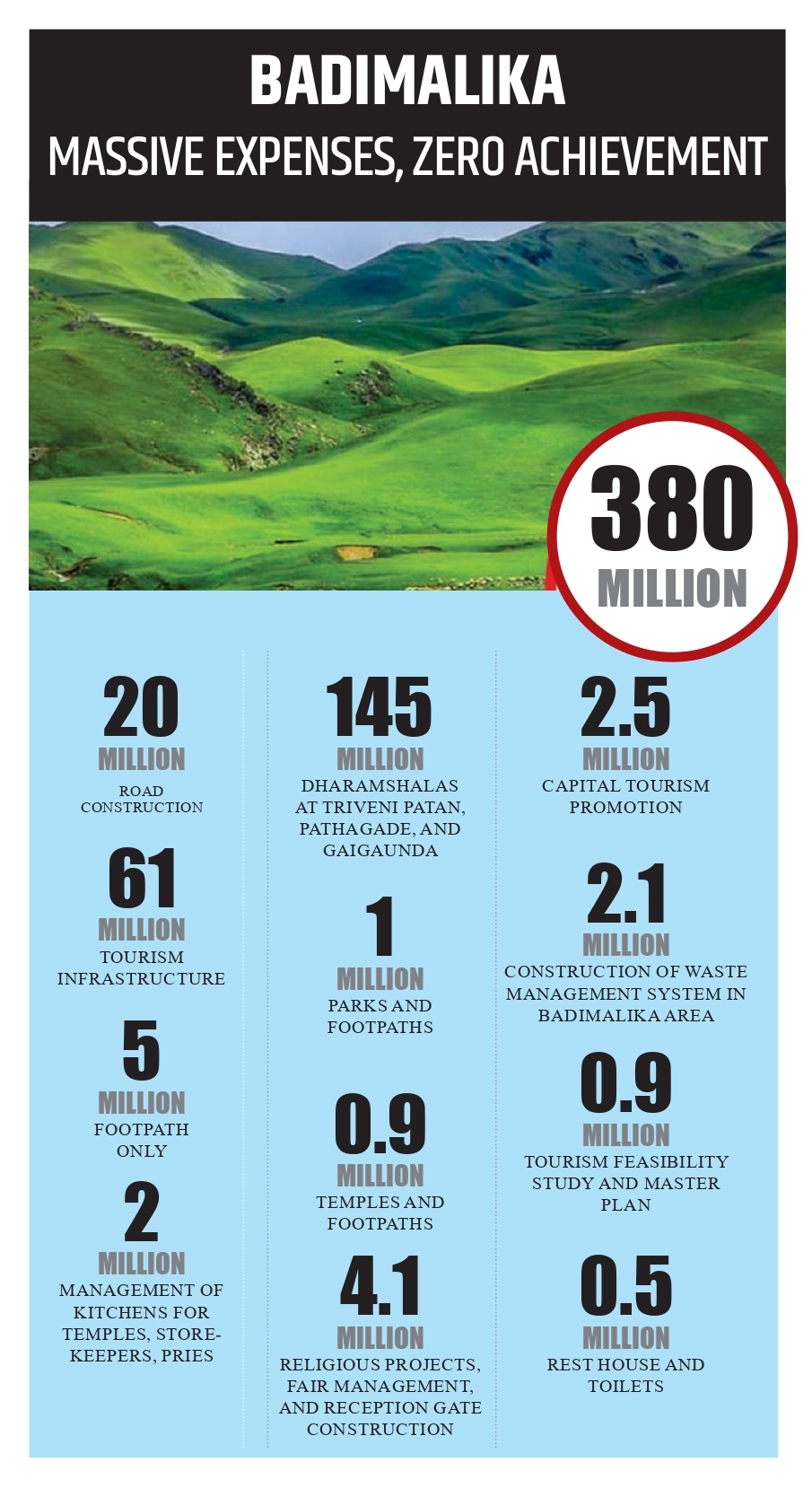 According to the initial plan, 1,420 meters of road had to be dug. But the contractor dug only 700 meters. Based on the survey information the contractor provided, the municipality disbursed 97.63 percent of the contract amount. According to the contract, the contractor DB Construction and Suppliers should have completed the construction work by July 4, 2020. But after the work was not completed, an extension of eight months was given and an amount equivalent to 97.63 percent of the contract, ie Rs 4.7 million, was disbursed utilizing the federal grant and the municipal budget. According to the Auditor General’s report, the local government should have paid the amount on its own after it couldn’t finish the work on time. But the local government spent Rs.2.3 million without following the due procedures.
According to the initial plan, 1,420 meters of road had to be dug. But the contractor dug only 700 meters. Based on the survey information the contractor provided, the municipality disbursed 97.63 percent of the contract amount. According to the contract, the contractor DB Construction and Suppliers should have completed the construction work by July 4, 2020. But after the work was not completed, an extension of eight months was given and an amount equivalent to 97.63 percent of the contract, ie Rs 4.7 million, was disbursed utilizing the federal grant and the municipal budget. According to the Auditor General’s report, the local government should have paid the amount on its own after it couldn’t finish the work on time. But the local government spent Rs.2.3 million without following the due procedures.
60 million rupee trail
After covering 41.5 km from Martadi, you’ll reach Badimalika Temple. It’s a popular destination for trekking amidst serene natural beauty and diverse wildlife. To get to Badimalika, there are four primary routes: Martadi-Phulchhauna-Triveni from Bajura, Sannitriveni from Kalikot, Nateshwari from Bajura, and Bhandar Griha to Badimalika via Paima.
A significant sum of 6.5 million rupees has been spent on constructing trails along these routes. The Tourism Department has accounted for 74.69 percent of this expenditure, totaling 49.139 million, over the course of three years (2019-20, 2020/21, and 2021/22). The contract for this work was awarded to Jalukeni Nirman Sewa, Balaju, Kathmandu. As per the contract agreement, Rishi Phuyal, the owner of Jalukeni, claimed to have built trails and four and constructed dharamshalas, railings, toilets, nets, and walls.
However, the road to Badimalika remains incomplete. Phuyal defended the delay, stating that conservation efforts were hindered by local shepherds who inadvertently damaged the infrastructure. Nevertheless, railings on the footpaths, and toilets were nowhere to be found during our visit.
This year, two pilgrims en route to the Badimalika fair tragically fell and lost their lives. DSP Kavindra Bohra, the Bajura District Police Chief, reported the deaths of Dhanprasad Neupane from Kalikot on August 28 and Bharat Budha from Bajura on August 29. Neupane succumbed to injuries sustained during a fall in the Triveni area, while an elderly man, Bharat Budha, passed away after collapsing while walking on the road, despite receiving treatment at a Nepali Army-run health camp.
Last year, Suresh Thagunna from Darchula suffered injuries in a fall near Vishnupani while returning from Badimalika. Additionally, five years ago, a tragic incident occurred when 63-year-old Damar Jaishi from Dhangadhi fell and lost his life while returning from Badimalika.
It’s worth noting that while ascending from Triveni Dham to Badimalika Temple, numerous paths intersect, leading first-time visitors astray due to a lack of clear road signs.
Dharmashalas come up, go down
Infrastructure such as dharamshalas and facilities for pilgrims traveling to Badimalika has been a persistent issue. The Ministry of Tourism, along with local authorities in Bajura and Kalikot, spent Rs 4.1 million over three years on topics like fair management during Janaipurnima and constructing reception gates. However, pilgrims continue to face a lack of basic amenities.
A 65-year-old woman named Taradevi Bohora from Kanchanpur expressed her concerns, saying, “As you can see, there’s a lack of accommodations and dining options on this road. Basic toilets are also nonexistent.”
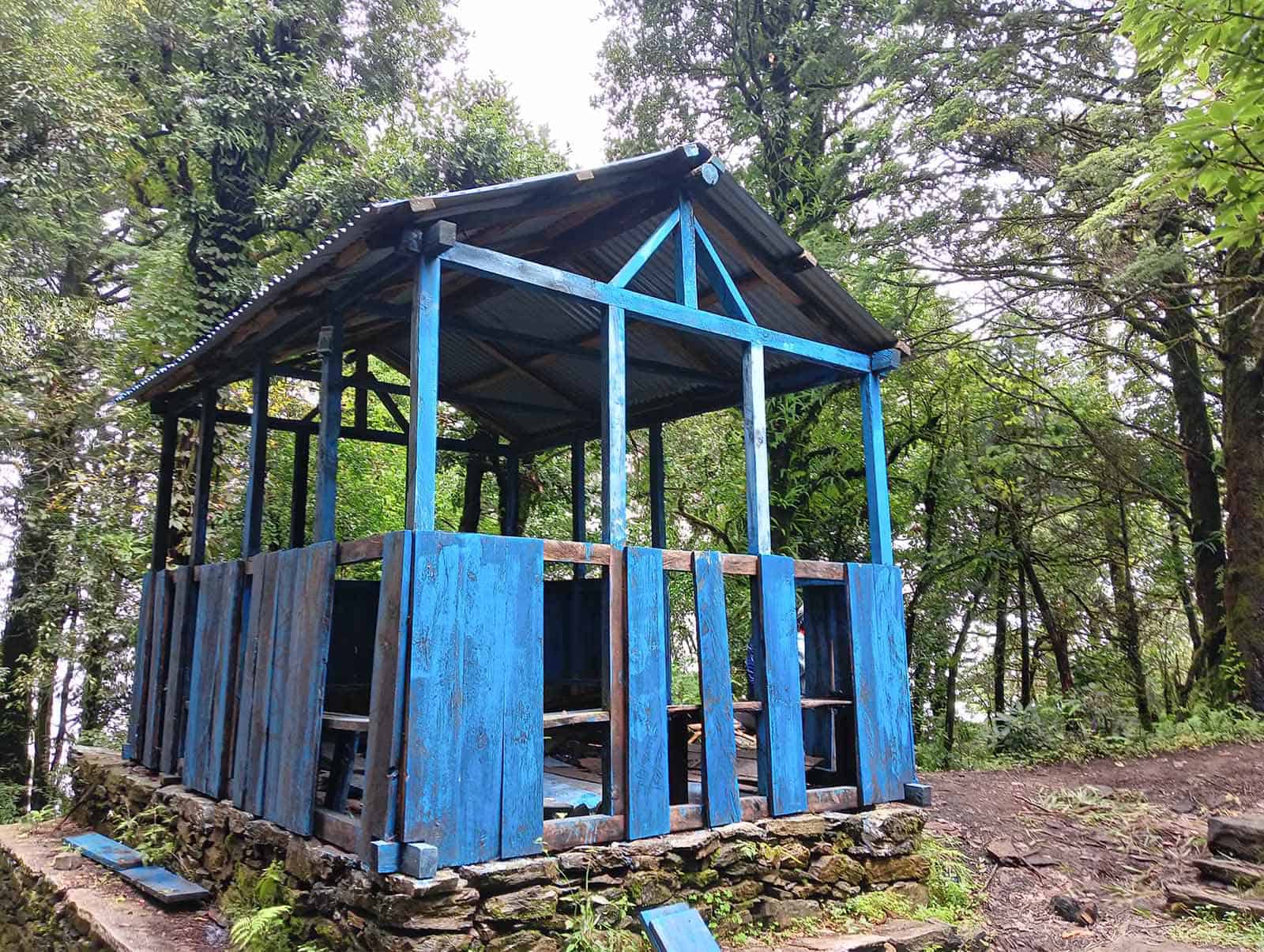
For instance, dharamshalas and other pilgrim facilities have been built but left unused and unusable. Four years ago, the Karnali provincial government constructed a dharmashala in Pattadoga, Kalikot, which collapsed within three days after payment was made to the contractor. Similarly, a dharamshala built for Rs 9 million in Triveni Patan and one for 2.5 million in Gaigounda also collapsed soon after completion.
In the last four years alone, the Karnali provincial government alone has spent Rs 59.5 million on tourism infrastructure in Triveni. However, most of these facilities have gone to waste, and accountability is lacking.
Mohan Bahadur KC, the president of Sannitriveni Rural Municipality, remarked on the Dharamshala built with substantial government funding, stating, “The dharamshala, constructed with significant government investment, hasn’t been utilised even for a single day. All that remains now are ruins. It’s baffling. Who is responsible for its construction? Who oversees these projects, and how were the payments made? It’s truly astonishing.”
En route to Badimalika, dharamshalas are situated both below and above Phulchhawana Patan, but they remain in an unusable state. Additionally, the waiting room constructed along the road has been reduced to ruins. There’s a notable absence of nearby water sources, and Dammar Thapa of Badimalika Municipality in Bajura pointed out, “To access water, one must walk for one and a half hours to reach the river or Setopatan. Furthermore, the path to the river is treacherous. Having only Dharamshala facilities is inadequate in these circumstances.”
In the fiscal year 2019/20, after completing the construction of the road from Sannitriveni Rural Municipality in Kalikot to Triveni Patan and finalising the Detailed Project Report (DPR), the rural municipality disbursed Rs 2.2 million to the construction company Mazdoor Construction. Suspicions have arisen regarding collusion, as the Auditor General’s report for the same year suggested that the road’s actual construction did not align with the documented plans.
Money disbursed by just looking at papers
In the subsequent fiscal year, Sannitriveni Rural Municipality approved a contract for constructing a trail to Chhapebhate Jiula Triveni Patan. The Auditor General’s report noted an additional expenditure of only Rs 500,000 was incurred by the rural municipality due to this contract. Moreover, security deposits of contractors who failed to fulfill their agreements were not confiscated.
In 2021/22, the same municipality paid Rs 1.9 million to Sandhya Consultancy Pvt. Ltd. for tourism promotion, a procurement process that deviated from the Public Procurement Regulations. According to Rule 71(1) of the Public Procurement Regulations 2064, public bodies are required to request technical and financial proposals in writing, sealed envelopes for procurements under Rs 2 million. However, in this case, the consultancy received payment without any signed letter or document related to the purchase.

These incidents highlight a pattern of financial mismanagement and irregularities. Similar problems have been observed in previous years, such as in 2018/19, where the back-hoe loader company’s payment was not made in accordance with Rule 36(3) of the Financial Procedures Regulations 2064.
The Auditor General’s Office has consistently pointed out such discrepancies, emphasising the need for financial discipline and accountability in the country.
The Auditor General’s report also highlights the ineffectiveness of investment in the tourism development of the Badimalika area in Sudurpaschim Province, as the implementation of tourism-targeted plans is carried out through the forest office in some districts and through the provincial tourism development unit.
Moreover, the existence of multiple agencies involved in the development of Badimalika has led to a lack of coordination. Bed Kumar Dhakal, Secretary of the Ministry of Industry, Tourism, Forestry, and Environment of the Sudurpaschim Province, notes that the absence of coordination among the three levels of government has led to problems related to transparency, quality of work, and more. He expressed concerns about the lack of a comprehensive master plan and municipalities independently pursuing their own approaches.
Remarkably, it is scarce to find a government body that has maintained comprehensive records of expenses incurred in Badimalika, and no government agency appears to maintain proper accounts.
Despite exercising the right to information and seeking details, the Nepal Tourism Board responded to us on November 6, 2022, stating that it doesn’t engage in construction work, focusing solely on promotional activities. However, just six days prior to this response, in collaboration with the United Nations Development Program (UNDP), Nepal Tourism Board, and Badimalika Municipality, waste management facilities were built in the forest slightly above Martadi, the Bajura headquarters, at a cost of Rs 2.1 million.
Lax monitoring
Lack of vigilant monitoring has exacerbated these irregularities. Yuvraj Khatiwada, Director and Spokesperson of the Tourism Department, explained that monitoring construction projects is costly and challenging, leading to payments being based on monitoring and reports from local municipalities. He expressed the need to ensure work quality at construction sites before making payments.

Undersecretary Teknarayan Paudel, who is also spokesperson for the Ministry of Tourism, stated that the ministry annually allocates budgets to the tourism sector to enhance tourism promotion. The implementation of these budgets relies on monitoring and reporting by municipalities. If funds are misused or if municipalities fail to adhere to agreements, coordination is necessary between the Ministry of Tourism, the provincial government, and the municipalities.
Badri Pandey, member of Parliament from Bajura, called for a detailed action plan to ensure proper utilisation of budgets allocated by various agencies for the Badimalika area within the current financial year. Without such a plan, there is a risk of budget mismanagement similar to previous years, he added.
Renuza Neupane, Planning and Monitoring Division Officer and Spokesperson at the Ministry of Industry, Tourism, Forestry, and Environment of Karnali Province, noted that the budget is allocated annually for major infrastructure development based on submissions by municipalities and wards according to local needs. Infrastructure development is a multi-year plan, and although monitoring is conducted, the limited staff faces challenges due to a heavy workload. She said, “Mismanagement is also happening in the capital budget, the Chief Minister’s Office has also started asking for DPR from this year, but thank you for raising the matter, we will strictly monitor it.”



